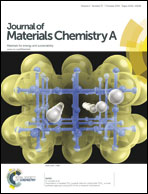Hybrid catalysts for photoelectrochemical reduction of carbon dioxide: a prospective review on semiconductor/metal complex co-catalyst systems
Abstract
Converting carbon dioxide (CO2) into more valuable chemicals is of great interest in recent years. This is one potential solution to the two problems behind the significant increase of CO2: global warming and limited fossil fuel resources. One technical effort is to develop CO2 involved photoelectrochemical approaches for solar fuel production. Using water as both an electron donor and a proton source would mimic the photosynthesis in plants. In the presence of water, however, the semiconductor photocatalyst generally suffers from low product selectivity and quantum efficiency. On the other hand, metal complex catalysts have shown high product selectivity and current efficiency in electrochemical reduction of CO2. Combining them as a co-catalyst with a semiconductor photocathode would improve the selectivity and efficiency. This article highlights the most recent progress in hybrid catalyst systems for photoelectrochemical reduction of CO2. It also provides the prospective discussion of factors that affect the catalyst and cell performance as well as the future challenges.


 Please wait while we load your content...
Please wait while we load your content...